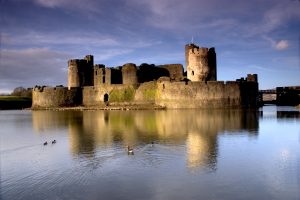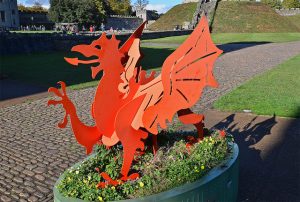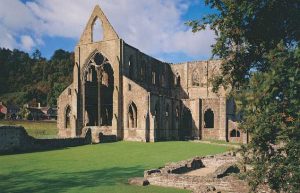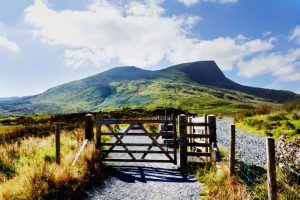 The outstanding natural beauty, varied landscapes-from dramatic peaks to lively seaside resorts, a distinctive Celtic heritage and a fine range of impressive castles, ruined abbeys, mansions and cities full of magnificent architecture have long attracted visitors to Wales. For long a country of spectacular scenery and a vibrant culture, specialising in male voice choirs, poetry, and a passionate love of team sports, Wales has now emerged from the yoke of its larger neighbour, and gained a degree of partial devolution with its own assembly established in Cardiff in 1999.
The outstanding natural beauty, varied landscapes-from dramatic peaks to lively seaside resorts, a distinctive Celtic heritage and a fine range of impressive castles, ruined abbeys, mansions and cities full of magnificent architecture have long attracted visitors to Wales. For long a country of spectacular scenery and a vibrant culture, specialising in male voice choirs, poetry, and a passionate love of team sports, Wales has now emerged from the yoke of its larger neighbour, and gained a degree of partial devolution with its own assembly established in Cardiff in 1999.
Much of the Welsh landmass is covered by the Cambrian Mountain Range, which effective acts as a barrier from England. Wales is warmed by the gulf steam and has a mild climate. Mainly unsuitable for arable farming, sheep and cattle thrive in this rugged terrain.
Welsh is an expansive and musical language spoken by only one fifth of the 2.7 million inhabitants, but it is the main language of conversation in many parts of North Wales in particular. There is an official by-lingual policy so that road signs, even in areas where Welsh is little spoken, are in English and Welsh, with Welsh place names providing a source of intrigue and obstacle to easy pronunciation for visitors. However many names simple describe features of the landscape or ancient buildings such as; Aber (estuary), Afon (river), Fach (little), Llan (church), Llyn (lake) and Nant (valley).
Wales was partially conquered by the Romans, but not by the Saxons and so the people retained a Celtic system of settlement and husbandry for 600 years before the Norman Conquest. This allowed for the development of a distinctive Welsh identity.
 The early Norman kings subjugated the Welsh, building massive castles and appointing “Marcher Lords” to keep their unruly subjects in check. They even made their first born sons “Princes of Wales”. It was not until 1535 under Henry VIII that Wales formally became part of the kingdom of England and Wales but religious non-conformity and radical politics remained deep-rooted in the Welsh consciousness. St David converted the country to Christianity in the 6th century but Methodism, chapel and teetotalism became entrenched in the 19th century. Even today some pubs stay closed on Sundays – although, thankfully, this is more and more of a rarity.
The early Norman kings subjugated the Welsh, building massive castles and appointing “Marcher Lords” to keep their unruly subjects in check. They even made their first born sons “Princes of Wales”. It was not until 1535 under Henry VIII that Wales formally became part of the kingdom of England and Wales but religious non-conformity and radical politics remained deep-rooted in the Welsh consciousness. St David converted the country to Christianity in the 6th century but Methodism, chapel and teetotalism became entrenched in the 19th century. Even today some pubs stay closed on Sundays – although, thankfully, this is more and more of a rarity.
A long standing oral tradition in Wales has produced many outstanding public speakers, politicians and actors. Welsh labour leaders have played an important role in the British Trade union movement and the rise of socialism. Welsh heritage is also steeped in song, music, poetry and legend: a tradition preserved by bards, minstrels and poets who have been associated with the druids. Bardic tales of quasi historical figures and magic were part of the oral tradition of The Dark Ages. They were first written down in the 14th century “Mabinogion”, which has inspired Welsh poets up to the 20th century’s Dylan Thomas. The male voice choirs found in many towns and valleys, particularly in the more industrial south, express a Welsh musical heritage which is celebrated in “Eisteddfods”, festivals of Welsh culture.
Cardiff (Welsh Caerdydd)
Cardiff is the capital and largest city in Wales, located at the mouths of the Taff and Ely rivers on the Bristol Channel. It is an important administrative, commercial and industrial centre. The population of Cardiff is around 325,000,comprising about a ninth of the population of Wales. St John the Baptist. Llandaff Cathedral, with its modern Epstein, Christus, was founded in the 6th century. Badly damaged in World War II, it has been completely restored. The city also boasts and impressive castle built on Roman foundations but now an ornate creation of William Burges.
Since the 1990s Cardiff has undergone significant redevelopment. The Docks area of Cardiff Bay has beentransformed into a new waterfront area incorporating the new Welsh Assembly building and the Wales Millennium Centre arts complex. The city centre has also undergone much development. As befitting the Welsh sporting passion new stadia have been developed in the last two decades including the Millennium Stadium for rugby, the country’s national sport, cricket’s SWALEC Stadium and, more recently, Cardiff City Stadium. Cardiff was the European City of Sport in 2009.
The Museum of Welsh Life, located in the St Fagan’s area of Cardiff, is one of Europe’s biggest open-air museums. It traces Wales’ journey from rural tradition to industrial powerhouse throughout its extensive galleries and over 100 acres of parkland.
Caerleon
Some of the best Roman remains in the country are to found in Caerleon in the Usk Valley. Formerly the important Roman base of Isca, it boasts the best- preserved amphitheatre in Britain.
Tintern Abbey
 Tintern Abbey is an extraordinarily lovely spot. Built by Cistercian monks in 1113, the abbey is the most handsome and most complete of Britain’s ruined monasteries. Such is the spectacular nature of the ruins that the Abbey has provided great inspiration for poets and artists including William Wordsworth’s “Lines Composed a Few Miles above Tintern Abbey” and Alfred, Lord Tennyson’s “Tears, Idle Tears”. Several J M W Turner paintings are also said to have been inspired by Tintern Abbey.
Tintern Abbey is an extraordinarily lovely spot. Built by Cistercian monks in 1113, the abbey is the most handsome and most complete of Britain’s ruined monasteries. Such is the spectacular nature of the ruins that the Abbey has provided great inspiration for poets and artists including William Wordsworth’s “Lines Composed a Few Miles above Tintern Abbey” and Alfred, Lord Tennyson’s “Tears, Idle Tears”. Several J M W Turner paintings are also said to have been inspired by Tintern Abbey.
Caerphilly Castle
Caerphilly Castle is one of the great medieval castles of western Europe, the largest in Britain after Windsor. Its immense size, its large-scale use of water for defence and the fact that it is the first truly concentric castle in Britain made it revolutionary masterpiece of military planning at the time of its building in the late 13th century.
Blaenafon
Commercial coal mining has now all but ceased in the south Wales valleys, an area which only 100 years ago was gripped by the search for its “black gold”. Although coal is no longer produced at Big Pit in Blaenafon, the Mining Museum provides a vivid reminder of living conditions in this tough industry.
Brecon Beacons
The Brecon Beacons National Park covers 520 square miles (1345 square kilometres) from the English border almost all the way to Swansea. Much of the area consists of high open country with smooth grassy slopes on a bedrock of red sandstone. The parks southern rim has limestone crags, wooded gorges, waterfalls and caves. This is an outstanding area of natural beauty for walkers and those wishing to enjoy outdoor pursuits. Dedicated walkers may enjoy following the path of Offa’s Dyke, the historic border between England and Wales.
Swansea and The Gower Peninsula
Swansea is Wales’ second city, set along a wide curving bay, and retains a traditional Welsh atmosphere. This is particularly noticeable in the excellent local food market full of Welsh delicacies such as laverbread and cockles. The award winning redevelopment of the maratime has transformed the old dockland with a fine Maritime and Industrial Museum. The Glyn Vivian Gallery and Swansea Museum are worth a visit as well as the streets Cwmdonkin Park made famous by Dylan Thomas.
Swansea bay leads to The Mumbles, gateway to the 18 mile long Gower Peninsula, which in 1956 was the first part of Britain to be declared an area of outstanding natural beauty.
The National Botanic Garden of Wales
Near the market town of Carmarthen, reputedly the oldest town in Wales, lies the National Botanic Gardens of Wales. Opened in 2000 it boasts formal gardens centred on the World’s largest single span glasshouse which contains a Mediterranean ecosystem.
Tenby
Georgian houses overlook a handsome harbour which is backed by a well preserved medieval cliff top town of narrow streets. The old town was once defended by a headland fortress flanked by two wide beaches and a ring of 13th century walls. These survive to their full height in places with an impressive fortified gateway. A Tudor Merchant House is proof on Tenby’s prosperity in seafaring days, and there are regular boat trips to the nearby monastic community of Caldy Island, home to perfume making.
Laugharne
Laugharne is a pretty town in Carmarthenshire, lying on the estuary of the River Taf. It is known for having been the home of Dylan Thomas from 1949 until his death in 1953, and is thought to have been an inspiration for the fictional town of Llareggub in Under Milk Wood. The poet’s “Boathouse” home with its writing shed overlooking the estuary can be visited as can the towns impressive 12th century castle. The Township was originally known as Abercorran, but this was changed to Laugharne after the Civil War, in honour of Major-General Rowland Laugharne, a renowned local army officer, who had commanded a Parliamentarian army, before rebelling in 1648.
St David’s
St David, the patron saint of Wales, founded a monastic settlement in this remote corner of south east Wales in the mid 6th century. This important Christina shrine was rebuilt in the 12th century with a bishops palace added a little later. Both are set in a charming grassy hollow below St David’s Town, officially Brittan’s smallest city.
Powis Castle
Powis Castle was built by Welsh princes around 1300 but hugely altered over the centuries. The terraced gardens, created between 1688 and 1722, are arguably the most dramatic in the country. Powis Castle and Garden is now under the care of the National Trust.
In 1784, the then Lord Powis’ daughter, Lady Henrietta Herbert, married Edward Clive, the eldest son of Clive of India. Their marriage led to the union of the Clive and Powis estates in 1801, and the Clive fortune paid for long overdue repairs to the castle. The garden and park were also improved and part of Clive of India’s fine collection of old master paintings, French and English furniture, and Italian curiosities, were brought to the castle.
Llandudno
Dominated by Great Orme’s Head, the site of Bronze Age copper mines, Llandudno, with its pier and canopied walkways retains much of the 19th century holidays spirit. The town is proud of its association with Lewis Carol as it is here that he reputedly met Alice Liddell, his inspiration for the tales of “Alice in Wonderland”
Snowdonia
 Snowdonia is Wales’ most mountainous region. Fourteen summits are above 900 metres and Snowdon itself is the highest at 1,085 metres. Sculpted by glacial activity, these mountains have been a playground for generations of climbers and walkers. Simply driving around Snowdonia is an exhilarating experience.
Snowdonia is Wales’ most mountainous region. Fourteen summits are above 900 metres and Snowdon itself is the highest at 1,085 metres. Sculpted by glacial activity, these mountains have been a playground for generations of climbers and walkers. Simply driving around Snowdonia is an exhilarating experience.
The Great Little Railways of Wales
As well as the scenic mountain railway to the summit of Snowdon, Wales boasts a number of scenic narrow gauge railways. Perhaps the most famous is the Ffestiniog which follows the old slate route from Porthmadog Harbour to the slate town of Blaenau Ffestiniog.
Caernarfon
One of Wales’ most famous castles looms over this busy little town. Built by Edward I following his defeat of the last native Welsh prince in 1283, the imposing castle and town walls merge with modern streets that spread beyond the medieval centre to a market square. Many remember the castle as the venue for the investiture, in 1969, of Prince Charles, as Prince of Wales.
Conwy
Conwy is one of Brittan’s most underrated historic towns, it boasts a concentration of medieval architectural riches unparalleled in Wales. The brooding castle, another construction by Edward I dominates the medieval town with its amazingly preserved medieval walls, fortified by 21 towers and 3 gateways.
Portmeirion
This extraordinary Italianate village, built on a private peninsula at the top of Cardigan Bay was the fantasy of Welsh Sir Clough Williams-Ellis. About 50 buildings surround the central piazza, in styles from Oriental to Gothic. Portmeirion has been the atmospheric location for many films and television programmes, most famously the popular 1960’s deletion series “The Prisoner”.
Bodnant Garden
Bodnant in North Wales has one of the finest gardens in the world. It is situated above the River Conwy on ground sloping to the south west and looks across the valley towards the Snowdon range. This magnificent garden was presented to the National Trust by Henry Duncan, 2nd Baron Aberconway in 1949. The garden is in two parts. The upper part around the house consists of the Terrace Gardens as well as informal lawns shaded by trees. The lower portion, known as The Dell, is formed by the valley of the River Hiraethlyn, a tributary of the Conwy, and contains the Pinetum and Wild Garden.
In March and April masses of daffodils and other spring bulbs make a colourful display. Pride of place amongst the shrubs is held by rhododendrons, magnolias, azaleas and camellias, which are in bloom in spring. The famous Laburnum Arch is also at its best and the Chilean Fire Bush (Embothrium lanceolatum’Norquinco’) provides a mass of colour in spring. In summer, water-lilies break the reflections of the Pin Mill in the Canal, roses and herbaceous borders decorate the terrace gardens. Bodnant has National Collections of Rhododendron forrestii, Magnolia, Eucryphia and Embothrium.
For more details about possible tours of Wales or to arrange a bespoke adventure, please get in touch with us.
